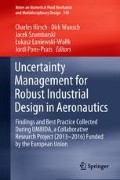Abstract
The present chapter investigates an uncertainty quantification (UQ) approach for the simulations of combustion instabilities (CI). They stem from the interaction between acoustic waves and heat release fluctuations. CI are harmful to gas turbines engines if they are not mastered at the design level. The targeted test case within the UMRIDA project is a realistic full annular helicopter combustor from Safran Helicopter Engines. This combustor is equipped with several burners and flames, each of them described by two uncertain input parameters. Therefore, we are facing a “curse of dimensionality” as around 10–20 independent uncertain parameters are generally involved in real combustors. In order to break the curse, active subspace methods (Constantine et al, J Sci Comput, 2013) and efficient surrogate techniques are used to assess the risk factor of the system, i.e., the probability of an acoustic mode to be unstable. For such high-dimensional complex systems, active subspace methods based on gradient correlations are known to provide dimension reduction of the necessary input parameters. Efficiency of the proposed method was shown effective on practical examples (Bauerheim et al. Combust Flame 161(5):1374–1389, 2014). In the scope of our overall approach, an Analytical Tool to Analyze and Control Azimuthal Mode in Annular Chambers named ATACAMAC (Bauerheim et al. Combust Flame 161(5):1374–1389, 2014) is used to deal with the complexity of the combustor features. Besides, it is hardly conceivable having recourse to 3D LES or even 3D Helmholtz solvers to deal with uncertainties in the high-dimensional spaces within a reasonable computational timeframe. To avoid expensive Helmholtz simulations, the quasi-analytical tool ATACAMAC is first applied to generate a reference Monte Carlo database to obtain the statistical benchmark database for the risk factor of the acoustic mode. Thereafter, the dimension of the system is drastically reduced to much less than 20–40 parameters using the active subspace methodology. Linear and quadratic surrogate models are introduced based on moderate active variables previously determined. Such models proved satisfactory in cheaply and accurately estimating the risk factor of the mode (Ndiaye et al, ASME Turbo Expo, 2015). The surrogate models are then fitted with the thousands of ATACAMAC simulations performed within the Monte Carlo analysis. These low-order models are then reused 100 000 times to determine the PDF of the growth rate of the acoustic disturbances, a necessary quantity to estimate the risk factor of the mode. A discussion ensued to evaluate the uncertainty quantification approach adopted.
Access this chapter
Tax calculation will be finalised at checkout
Purchases are for personal use only
References
Bauerheim, M., Parmentier, J.F., Salas, P., Nicoud, F., Poinsot, T.: An analytical model for azimuthal thermos-acoustic modes in an annular chamber fed by an annular plenum. Combust. Flame 161(5), 1374–1389 (2014)
Boileau, M., Staffelbach, G., Cuenot, B., Poinsot, T., Berat, C.: LES of an ignition sequence in a gas turbine engine. Combust. Flame 154(1), 2–22 (2008)
Constantine, P., Dow, E., Wang, Q.: Active subspace methods in theory and practice: applications to kriging surfaces. SIAM J. Sci. Comput. 36(4), A1500–A1524 (2014)
Moureau, V., Lartigue, G., Sommerer, Y., Angelberger, C., Colin, O., Poinsot, T.: Numerical methods for unsteady compressible multi-component reacting flows on fixed and moving grids. J. Comput. Phys. 202(2), 710–736 (2005)
Ndiaye, A., Bauerheim, M., Moreau, S., Nicoud, F.: Uncertainty quantification of thermo-acoustic instabilities in a swirled stabilized combustor. In: ASME Turbo Expo (2015)
Wolf, P.: Ph.D. thesis, INP Toulouse (2010)
Author information
Authors and Affiliations
Corresponding author
Editor information
Editors and Affiliations
Rights and permissions
Copyright information
© 2019 Springer International Publishing AG, part of Springer Nature
About this chapter
Cite this chapter
Richard, S., Lamouroux, J., Ndiaye, A., Nicoud, F. (2019). Application of UQ to Combustor Design. In: Hirsch, C., Wunsch, D., Szumbarski, J., Łaniewski-Wołłk, Ł., Pons-Prats, J. (eds) Uncertainty Management for Robust Industrial Design in Aeronautics . Notes on Numerical Fluid Mechanics and Multidisciplinary Design, vol 140. Springer, Cham. https://doi.org/10.1007/978-3-319-77767-2_25
Download citation
DOI: https://doi.org/10.1007/978-3-319-77767-2_25
Published:
Publisher Name: Springer, Cham
Print ISBN: 978-3-319-77766-5
Online ISBN: 978-3-319-77767-2
eBook Packages: EngineeringEngineering (R0)

